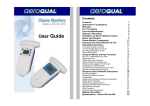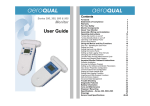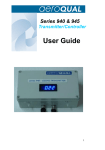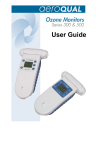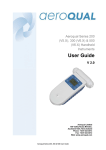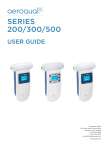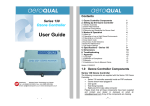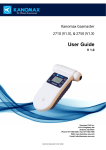Download Aeroqual 200 Series User guide
Transcript
Series 300, 305, 500 & 505 200Monitor User Guide 1 Quick Start Guide 1. Unpack monitor and check supplied components are correct Insert Battery (see section 3.0) Insert Sensor When new, plug in the power adaptor and turn on your monitor (with sensor head installed) for 24hrs. Note: The battery requires 15hrs from full discharge. The sensor requires a run in period. Thereafter, the normal warm up takes only 10 minutes. If your unit is new or unused for a long period, a warm up message may display for several hours, then will disappear. Follow the operating instructions to understand how to make the most of your monitor 2. 3. 4. 5. 2 3 1. 2. 3. 4. 5. 1 Sensor Head Power and Stand By Display Enter Battery case. For battery installation, see section 3.0 of your user guide 4 5 EXIT ZERO CAL CONC UNIT MAX MIN AV ZERO CAL: Please refer to section 4.5 of your user guide when using this option, as this can uncalibrate your unit if performed incorrectly CONC UNIT: To change the units of measurement, use the power key, then press to return to the main menu. See section 4.6 of your user guide for more information MAX / MIN AV: To adjust the max / min av, press to alternate between start and stop. See section 4.7 of your user guide for more information Warning: • • Do not expose the monitor to gas concentrations above the recommended maximum range Do not place the sensor head in a gas stream – the monitor is designed to measure ambient levels of ozone and uses ‘active sampling’ to achieve this. 1 Contents 1.0 Monitor Components 2.0 About Your Monitor 3.0 Assembly and Installation 3 4 5 3.1 Battery pack 3.2 Sensor warm up 3.3 Monitor and Sensor Versions 5 8 8 4.0 Operating Instructions 9 4.1 Turning the Monitor on and off 4.2 Operating under battery power 4.3 Sensor Head Failure 4.4 Using the Menus & Key Functions 4.5 Zero Calibration 4.6 Changing Unit of Measurement 4.7 Max Min Average Measurement Cycle 4.8 Alarm Mute (Perc only) 4.9 Alarm (Perc only) 4.10 Alarm Level (Perc only) 9 10 10 11 11 12 12 13 13 14 5.0 Troubleshooting 6.0 Specifications 7.0 Drawings 8.0 Care and Maintenance 9.0 For Your Safety 10.0 Statements of Compliance 11.0 Warranty 12.0 Copyright 13.0 Guidelines on how to measure ozone 14.0 Zero calibration additional information 15.0 Sensors and accessories 15 17 18 18 20 21 22 24 25 26 27 08.11.2010 V1.1 2 1.0 Monitor Components Series 200 Monitor The following components are supplied with the Series 200 Monitor: • • • • • Series 200 monitor base Gas sensor head 12 VDC 800 mA AC/DC adaptor User guide Battery pack – 9.6 V Please check that all these components have been supplied and contact your dealer or Aeroqual by email at: [email protected] if any of the components are missing. Replacements Replacement batteries, sensor heads and other accessories can be purchased separately. Note: All sensors deteriorate over time. It will be necessary to replace your sensor head with either a new or refurbished head. This must be done on a scheduled basis or when the “sensor aging” or sensor failure” diagnostic appears. Bump tests, zero and span calibration can be performed under specified conditions with appropriate tools. 3 2.0 About Your Monitor The Aeroqual Series 200 Monitor has been specifically designed to incorporate Aeroqual’s in-depth knowledge of accurate ambient gas measurement. Different sensor heads are used for specific gases or depending upon whether high or low concentrations are to be measured. The all sensor heads are interchangeable on the same base unit. The following information details the operation and features of the monitor: 1. The monitor is modular in design and is comprised of two main components, a Series 200 monitor and a sensor head. This affords the user the ability to replace faulty sensor heads without having to replace the monitor. The monitor can be mains and/or battery powered and either permanently mounted or used as a portable unit. 2. The Aeroqual Series 200 Monitor comes with in-built diagnostics, which will inform the user if the sensor is not operating correctly. 3. An audible alarm is available with perchloroethylene sensors only. Both temporary and permanent mute functions are also included with the audible alarm. 4. Concentration unit selection. The concentration can be displayed in either ppm or mg/m3. 5. Min / max / average measurement cycle. The monitor will display the minimum, maximum, average and 15-minute average gas concentrations over the measurement period. 4 3.0 Assembly and Installation Assembly The following needs to be completed before the Monitor is ready for use: • Insert the sensor head into the top of the monitor. The sensor head is keyed to ensure the head is inserted correctly. • If the monitor is a mains only unit it is ready for use. If the monitor is to be used as a portable unit with batteries then the batteries must be installed and charged prior to use. 3.1 Battery Pack • Remove the battery cover from the monitor. • Insert the battery power connector into the monitor power socket in the back of the monitor. • Lay the battery cable into the slot on the back of the monitor and insert the tail end of the battery pack into the hinge points at the bottom of the monitor back cover. • Clip the top end of the battery pack into the top clips, taking note to orientate the battery pack per the instructions on the battery pack. • Replace the battery cover on the monitor. 5 Removing the Battery Pack • Remove the battery cover from the monitor. • Insert your thumb under the top left hand side of the battery pack and carefully lever the battery pack out from the retaining clips. • Unclip the connector from the monitor. • Replace the battery cover. Rechargeable Batteries The optional Ni-MH (Nickel Metal Hydride) battery pack is used to power the monitor as a portable unit. Please read the following information carefully before using the battery pack to operate the Aeroqual monitor. Safety Do not use the battery pack for any other purpose than oper• ating the Aeroqual monitor • Do not disassemble or mutilate the batteries as this may cause burns • Do not incinerate or heat as this may cause burns, the batteries may burst or cause the release of toxic materials • Do not short circuit as this may cause burns • Use only batteries approved by Aeroqual and recharge your battery only with the AC/DC adaptors supplied by Aeroqual. • Never use any charger or battery that is damaged or worn out. • Batteries must be recycled or disposed of properly. They must not be disposed of in municipal waste. • Never charge a Ni-MH in a hermitically sealed container. Using the battery pack The life of the battery pack will be affected by the way it is handled. Take good care of the battery pack and follow the guidelines suggested in the following section. 6 Charging and Discharging the Batteries New Ni-MH batteries must be fully charged prior to use. A new NiMH battery's full performance is achieved only after a number of complete charge and discharge cycles. A fully charged battery will run for approximately 4-5 hours. (Note: Perc sensor heads require more power and will run for a shorter time) Charging Instructions 1) Plug in the adaptor 2) Turn the monitor on 3) Allow 15 hours for the battery to fully charge. Note: • During charging the battery symbol on the display flashes slowly. • The battery can be charged with the sensor head installed or removed from the base. (Remember to switch off the monitor before removing the sensor head). • Unplugging the main power will reset the above charging conditions. • The batteries can be charged and discharged many times but will eventually wear out. When the operating time is noticeably shorter than normal, it is time to replace the batteries. • It is not necessary to fully discharge the batteries. When not using the Series 200 Monitor as a portable unit, always plug in the mains adaptor to recharge the batteries with the monitor switched on. • If left unused a fully charged battery will discharge itself over time. Note: If you have difficulty charging the battery, either: A) Replace the battery B) Contact Aeroqual with the software version number (see section 3.3 to locate the version number.) 7 Installing the AC/DC adaptor • Connect the AC/DC adaptor to the mains supply. Ensure that the adaptor is correctly rated for the power supply. • Plug the adaptor into the monitor. The monitor can now be used as a mains unit. If the monitor is to be used as a portable unit the batteries will need to be charged. 3.2 Sensor warm up Prior to operation the monitor must be warmed up to burn off contaminants on the sensor. When the monitor is first switched on it will warm up for 3 minutes. Then the reading will flash for the next 7 minutes to indicate that the sensor is still in the warm up phase. It is recommended that the monitor is kept in Stand By mode when not being used to keep the sensor heated and prevent the build up of contaminants. If the sensor is new (or unused for long periods) it can take up to 24 hours for the message “sensor warming up” (or “sensor failure” in older models) to disappear. Should the message remain after this time, a genuine sensor failure may have occurred. See the troubleshooting guide. Since O3 is an oxidising gas the warm up period can be reduced by subjecting the sensor to elevated O3 levels for a short period. For example, 100 ppb of O3 for 5 minutes typically reduces the warm up time to 30 minutes. 24hrs is a conservative time for an ozone sensor to burn off contaminants and achieve its stated performance specification. In most instances this will be achieved well within 24hrs. Warning: Do not remove the sensor head while the monitor is switched on. This may damage the unit. If the sensor head is removed under these conditions, the unit will automatically shut down. 3.3 Monitor and Sensor Versions Turning the monitor on will display “AEROQUAL MONITOR V x.x”, where "V x.x" represents the version of the monitor base. The display will then show “SVXX” which indicates the software version installed on the sensor head. 8 4.0 Operating Instructions The following instructions detail the operation and set up of the monitor. Power button Enter Key 4.1 Turning the monitor on and off To turn the monitor on, press & hold the power button until the screen activates. The monitor will turn on and the display will show “AEROQUAL MONITOR S200 / S205 Vx.x”,. After 5 seconds the display will change to indicate the type of sensor head. The monitor will warm up as described in “Warm up” in section 3.2. Once warm up is complete the main display will appear (for example): O3 LOW 0.009 ppm Note: The number of decimal places shown will vary depending on the sensor head type To turn the monitor off, press and hold the power button for 2 seconds until the monitor beeps. The display will now be blank and operation of the monitor will cease. 9 Turning Standby Mode on and off To activate Standby Mode with the monitor on, press the power button once. This will stop operation of the monitor; however the sensor will be kept warm. This mode is used to conserve power between operations but keep the sensor ready to measure the gas concentration with only a short warm up phase as described in “Warm up” in section 3.2. In this mode the display will be as shown below: NH3 To return the monitor to operational mode press the power button once. NOTE: When using a Carbon Dioxide sensor head in standby mode, the sensor runs at full power and the fan remains on. 4.2 Operating under Battery power A battery indicator will appear at the bottom of the display when the monitor is operating under battery power only. The indicator shows the battery life remaining. O3 LOW 0.080 ppm 4.3 Sensor Head Failure There are two possible Sensor failure modes, which will be indicated by one of the following messages on the display: “Sensor Failure, Replace sensor” – The sensor head should be replaced as this indicates that there has been component failure. “Sensor aging”: - This indicates that the sensor has reached the end of its usable life and the sensor head should be replaced as soon as possible. The measurement readings can no longer be relied upon to be within specification. 10 4.4 Using the Menus and Key Functions To enter the setup menu press appear: Normal Menu Special Perc Menu EXIT ZERO CAL CONC UNIT MIN MAX AV Press The following menus will EXIT ZERO CAL CONC UNIT MIN MAX AV ALARM MUTE ALARM ALARM LEVEL or to scroll to the desired menu. 4.5 Zero Calibration The “ZERO CAL” routine resets the zero point of the monitor. "ZERO CAL" must be carried out under carefully controlled conditions, as specified below. Minimum 24 hours warm up Clean air (charcoal filtered is best), no cross-sensitive gases Stable and low air flow around the monitor No vibration or movement of the monitor Temperature at 20°C ± 2°C (68°F ± 3.5°F) Relative Humidity of 50% ± 5% An incorrect "ZERO CAL" does not cause permanent damage. The process should be repeated under the above conditions. NOTE: Carbon Dioxide sensors MUST be calibrated in a certified Zero Air environment. If in doubt contact Aeroqual Limited. Press and hold until the word GO appears next to Reset Routine. The routine will run for up to ten minutes (depending on the gas sensor installed) and then beep to indicate completion. Talk to your supplier or distributor if you have questions. Press • to scroll down to the next menu choice. See section 13.0 for more information 11 4.6 Changing Unit Of Measurement (Concentration Unit) To enter the ‘CONC UNIT’ menu press will appear. . The unit display OZONE UNIT: ppm (or) mg/m3 Press to scroll between ‘ppm’ or ‘mg/m3’ Press to confirm the unit selection Press to scroll down to the next Menu choice 4.7 The Max/Min/Average Measurement Cycle Pressing starts the Min Max Av routine Press to scroll to ‘EXIT’ Press to Exit out of Menu Setup. The following display will appear:VOC O3 LOW . M I N 0.005 M A X 0.024 AV 0.015 MIN 5 MAX 25 AV 15 ST 17 0.008 ppm 18 ppm Repeat the above sequence to stop the Min Max Av routine. Note: The MIN, MAX and AVE readings are the minimum, maximum and average readings over the period from the start of the cycle. The ST value is the average over the last 15 minutes 12 4.8 ALARM MUTE (for PERC only) Note: With “Alarm Mute ON” (enabled) the alarm condition will be muted only until the gas concentration drops below the alarm level – remember this is a temporary mute function. To enter the “ALARM MUTE” menu press screen will appear: - and the following ALARM MUTE OFF Press to toggle between “ALARM MUTE OFF” and “ALARM MUTE ON”. Press to confirm your choice and you will return to the main menu. If you select “Alarm Mute On” and exit the menu, the symbol concentration screen. Press will be displayed on the gas to scroll down to the next menu choice. 4.9 ALARM (for PERC only) To enter the “ALARM” menu press screen will appear: - and the following ALARM PERMANENT ON Press to toggle between “ALARM PERMANENT ON” and “ALARM PERMANENT OFF”. Press choice and you will return to the main menu. 13 to confirm your If you select “Alarm Permanent OFF” and exit the menu, the P will be displayed on the gas concentration symbol screen to indicate that the alarm has been permanently muted. Press to scroll down to the next menu choice. 4.10 ALARM LEVEL (for PERC only) To enter the “ALARM LEVEL” menu press ing screen will appear: - and the follow- ALARM LEVEL 50PPM Press 35PPM. to toggle between 50PPM, 100PPM, 150PPM and Press to confirm your choice and you will return to the main menu. Whatever alarm level you have chosen will be displayed on the bottom left of the main display screen. NOTE: The altered alarm level will remain active until the Monitor is switched off after which it will revert to the 50PPM default level. Press to scroll up to the “EXIT” menu choice and press to exit to the main screen. 14 5.0 Troubleshooting Series 200/205 Fault Description Possible cause Remedy No power Lead connection broken Reconnect power lead Power supply failure Replace 12V DC power supply Battery flat Recharge battery S200 damaged Replace unit Sensor head damaged Replace sensor head Sensor failure when the sensor is new Insufficient warm up Run the sensor on full power for 24-48 hours. If an ozone source is available, exposure to 100 ppb for 5 minutes will speed up the decontamination process (approximately 30 minutes) Reading high under zero gas conditions Reading lower than expected reading in the presence of sensor gas Air contaminated Move the sensor to cleaner environment and check reading Sensor damaged Background gas level higher than normal Replace sensor Move sensor to clean air and recheck baseline Interferent gas present Move sensor to clean air and recheck baseline Sensor damaged Replace sensor Sensor correct Check calibration of gas generator. Sensor inlet contaminated Clean sensor inlet filter and mesh Sensor fan failed Replace sensor 15 Interferent gas present Move sensor to clean air and check reading upon exposure to known gas concentration Gas reactive and decomposing before detection Move the monitor closer to the source of the gas Local air flow too high (ozone sensors) or too low (VOC and ammonia sensors) Modify the airflow into and around sensor head. Sensor calibration lost Replace /refurbish sensor Fault Description Possible cause Remedy Reading higher than expected in the presence of sensor gas Sensor correct Check calibration of gas generator. Interferent gas present Move sensor to clean air and check reading upon exposure to known gas concentration Sensor calibration lost Power supply unstable Replace /refurbish sensor Install stable power supply Reading unstable Power supply current rating incorrect Install power supply with correct rating Reduce air flow Local air flow too high Reduce fluctuations Environmental conditions fluctuating 16 6.0 Specifications Series 200 Monitor Base Measurement units PPM or mg/m3 Removable / replaceable sensor head Yes On-board alarm* Yes Alarm status displayed * Yes Low battery indication Yes Alarm mute function* Yes Sensor condition status Yes Stand-by mode Yes External signal for alarms & control None External signal functions None Analogue output None Power supply 12 VDC, 800 mA Rechargeable battery pack 9.6V (2100mA/hr Ni-MH ) Portable Yes Permanently fixable Screw fix Remote Sensor Capability Yes Enclosure rating IP20 & NEMA 1 equivalent Size (with sensor head) 195 x 122 x 54 (mm); 7R x 4¾ x 2T (in) Weight (with sensor head and battery) < 460 g; < 16 oz Approvals Part 15 of FCC Rules EN 50082-1: 1997 EN50081-1: 1992 *Perc sensor only 17 7.0 Drawings Depressions in the battery cover demarcating the screw-hole positions for fixing the unit to the wall. 18 8.0 Care and Maintenance Your Aeroqual Monitor is a product of superior design and quality and should be treated with care. When using your Aeroqual Monitor: • Keep it and all its parts and accessories out of the reach of small children. • Keep it dry. Avoid water and/or condensation as humidity and liquids containing minerals may corrode electronic circuits. • Do not use or store in dusty, dirty areas. • Do not store or turn off the monitor in temperatures below 10°C. • This unit is designed for use at temperatures between -5°C and +50°C (23°F and 120°F). Sudden changes in temperature will cause condensation that may damage the electronic componentry. • Do not attempt to open. Non-expert handling of the device may cause damage. • Do not drop, knock or shake as this could lead to internal damage. • Do not use harsh chemicals, cleaning solvents or strong detergents for cleaning. Wipe with a soft cloth slightly dampened with a mild soap-and-water solution In order to maintain measurement accuracy, Aeroqual recommends that user’s replace or refurbish their sensor heads on a yearly basis. Please contact your dealer or Aeroqual to discuss your options. Disposal / Recycling Please note that this is an electronic product and disposal should be in line with your local or country legislation. The plastic casing of the product is made from a Polycarbonate / ABS blended material (PC + ABS) and is marked accordingly. 19 9.0 For Your Safety Read these simple guidelines. Ignoring these guidelines may be hazardous. USE SENSIBLY Use only as per this user guide. USE AEROQUAL APPROVED SERVICE Only approved service personnel must work on this product. ACCESSORIES Use only approved accessories. Do not connect incompatible products. CONNECTING TO OTHER DEVICES When connecting to any other device, read the appropriate user guide for detailed safety instructions. Do not connect incompatible products. HAZARDOUS ENVIRONMENTS (Ozone Sensors Only) Do not use the Ozone Sensors in or near volatile fuel or chemicals. HEALTH AND SAFETY IN THE WORKPLACE The Aeroqual Series 200 Monitors and Sensor Heads are used to monitor ambient gas concentrations. Aeroqual does not guarantee user safety. In hazardous environments, an appropriate Health and Safety plan should be in place. 20 10.0 Statements of Compliance 1. The Aeroqual Series 200 Monitor and Remote Adaptor Kit comply with EN 50082-1:1997 The Aeroqual Series 200 Monitor and Remote Adaptor Kit comply with EN 50081-1:1992 The Aeroqual Series 200 Monitor and Remote Adaptor Kit comply with Part 15 of the FCC Rules. Operation is subject to the following two conditions: (1) these devices may not cause harmful interference, and (2) these devices must accept any interference received, including interference that may cause undesired operation. 2. 3. NOTE: This equipment has been tested and found to comply with the limits for a Class B digital device, pursuant to Part 15 of the FCC Rules. These limits are designed to provide reasonable protection against harmful interference in a residential installation. This equipment generates, uses and can radiate radio frequency energy and, if not installed and used in accordance with the instructions, may cause harmful interference to radio communications. However, there is no guarantee that interference will not occur in a particular installation. If this equipment does cause harmful interference to radio or television reception, which can be determined by turning the equipment off and on, the user is encouraged to try to correct the interference by one or more of the following measures: 21 • • Reorient or relocate the receiving antenna. • Connect the equipment into an outlet on a circuit different from that to which the receiver is connected. • Consult the dealer or an experienced radio/TV technician for help. Increase the separation between the equipment and receiver. 11.0 Warranty Thank you for purchasing this Aeroqual product. To get maximum use of the features of your new product we recommend that you follow a few simple steps: Read the guidelines for safe and efficient use. Read all the terms and conditions of your Aeroqual Warranty. Save your original receipt. You will need it for warranty repair claims. Should your Aeroqual product need warranty service, you should return it to the dealer from whom it was purchased or contact Aeroqual. Our Warranty Aeroqual warrants this product to be free from defects in material and workmanship at the time of its original purchase by a consumer, and for a subsequent period as stated in the following table: Products Warranty Period Series 200 monitor base One year from the date of purchase Sensor heads – all gases Six months from the date of purchase Accessories Batteries Three months from the date of purchase Other Accessories One year from the date of purchase This warranty is expressly limited to the original owner who purchases the equipment directly from Aeroqual or from an authorized Aeroqual dealer. What we will do If, during the warranty period, this product fails to operate under normal use and service, due to improper materials or workmanship, Aeroqual subsidiaries, authorized distributors or authorized service partners will, at their option, either repair or replace the product in accordance with the terms and conditions stipulated herein. 22 Conditions • • • • • • • • • • The warranty is valid only if the original receipt issued to the original purchaser by the dealer, specifying the date of purchase, is presented with the product to be repaired or replaced. Aeroqual reserves the right to refuse warranty service if this information has been removed or changed after the original purchase of the product from the dealer. If Aeroqual repairs or replaces the product, the repaired or replaced product shall be warranted for the remaining time of the original warranty period or for ninety (90) days from the date of repair, whichever is longer. Repair or replacement may be via functionally equivalent reconditioned units. Replaced faulty parts or components will become the property of Aeroqual. This warranty does not cover any failure of the product due to normal wear and tear, damage, misuse, including but not limited to use in any other than the normal and customary manner, in accordance with Aeroqual’s user guide for use, faulty installation, calibration and maintenance of the product, accident, modification or adjustment, events beyond human control, improper ventilation and damage resulting from liquid or corrosion. This warranty does not cover product failures due to repairs, modifications or improper service performed by a non-Aeroqual authorized service workshop or opening of the product by non-Aeroqual authorized persons. The warranty does not cover product failures which have been caused by use of nonAeroqual original accessories. This warranty becomes void if a non-Aeroqual approved AC/DC adaptor or battery is used. Tampering with any part of the product will void the warranty. Damage to the sensors can occur through exposure to certain sensor poisons such as silicones, tetraethyl lead, paints and adhesives. Use of Aeroqual sensors in these environments containing these materials may (at the discretion of Aeroqual) void the warranty on the sensor head. Exposure to gas concentrations outside of the design range of a specific Aeroqual sensor head can adversely affect the calibration of that sensor head and will also void this warranty as it applies to the replacement of sensor heads. Aeroqual makes no other express warranties, whether written or oral, other than contained within this printed limited warranty. To the fullest extent allowable by law all warranties implied by law, including without limitation the implied warranties of merchantability and fitness for a particular purpose, are expressly excluded, and in no event shall Aeroqual be liable for incidental or consequential damages of any nature whatsoever, however they arise, from the purchase or use of the product, and including but not limited to lost profits or business loss. Some countries restrict or do not allow the exclusion or limitation of incidental or consequential damage, or limitation of the duration of implied warranties, so the preceding limitations or exclusions may not apply to you. This warranty gives you specific legal rights, and you may also have other rights, which may vary from country to country. 23 12.0 Copyright Copyright Aeroqual Limited. All rights reserved. Reproduction, transfer, distribution or storage of part or all of the contents of this document in any form without the prior written permission of Aeroqual Limited is prohibited. “Aeroqual” and “Aeroqual Limited – Making the Invisible Visible” are registered trademarks of Aeroqual Limited. Other product and company names mentioned herein may also be trademarks or trade names. Aeroqual operates a policy of continuous development. Aeroqual reserves the right to make changes and improvements to any of the products described in this document without prior notice. Under no circumstances shall Aeroqual be responsible for any loss of data or income or any special, incidental, consequential or indirect damages howsoever caused. The contents of this document are provided "as is". Except as required by applicable law, no warranties of any kind, either express or implied, including, but not limited to, the implied warranties of merchantability and fitness for a particular purpose, are made in relation to the accuracy, reliability or contents of this document. Aeroqual reserves the right to revise this document or withdraw it at any time without prior notice. The availability of particular products may vary by region. Please check with the Aeroqual dealer nearest to you. 24 13.0 Guidelines on How to Measure Ozone The following information is presented to help users operate their Aeroqual monitor with an ozone sensor installed in the most effective and efficient manner. General Ozone is heavier than air and tends to sink. Thus detection • of leaks from ozone generating equipment should be performed at the most appropriate position. Ozone will react and decompose on surfaces such as walls, furniture etc. Smell is not a reliable test for the presence or concentration of ozone as the odour threshold varies widely between people and is affected by local ambient conditions. • • Permanent Controller Placement The Aeroqual Ozone Controller has been designed to meas• ure the ambient concentration of ozone. The controller must not be placed directly in an ozone stream. For indoor local area monitoring attach the controller to an inert surface with the inlet unobstructed. For leak detection mount the unit near the ozone equipment. Ensure that the controller is protected from excessive water splashing, dust, vibration, excessive heat or cold, high concentrations of ozone and excessive swings in humidity. • • • False Readings • The Aeroqual Ozone Controller has been designed to respond selectively to ozone, however other oxidizing gases such as chlorine and nitrogen dioxide can generate false readings if they are at high concentrations. High concentrations of hydrocarbon gases such as vapours of alcohol, oils and solvents can reduce and mask the concentration of ozone. 25 14.0 Zero calibration additional Information A zero calibration menu routine is included in the Series 200, however it is important to understand when this should be used. All Aeroqual sensors are supplied pre-calibrated and zero calibration is performed in the factory in an atmosphere containing < 0.5 ppm hydrocarbons, 50% relative humidity and 25 oC. Zero baseline reading checks should be performed ideally under the same conditions. Why is the baseline not zero when no sensor gas is present ? Under some circumstances the sensors may exhibit a baseline reading higher than zero. This will be due to one of the following: • The sensor has not warmed up sufficiently. The sensor should be left to run in clean air for 24 hours if it is new or has not been used in the past week. • There are trace levels of gases present in the air to which the sensor is cross-sensitive. In many cases, the non-zero baseline reading occurs in an environment which is supposed to be "clean" but for which no analysis has been carried out, such as, an office or urban outdoor air. Re-check the baseline reading in clean air from a known source such as a zero air cylinder or clean outdoor air. • The humidity of the air is significantly different to 50 % RH. Under this condition the sensor may display a small shift in the baseline reading (<1% of fullscale). • There has been some drift in the baseline. When should I perform a zero calibration ? • If the sensor has been warmed up in a clean air environment and it still displays a small positive after 24 hours then a zero calibration can be performed. This process takes only a few minutes and can be performed repeatedly without problems. (See section 4.5 Zero calibration.) 26 15.0 Sensors and accessories Gases Ranges Ammonia (NH3) 0 - 100 ppm 0 - 1000 ppm Carbon monoxide (CO) 0 - 100 ppm 0 - 1000 ppm Carbon dioxide (CO2) 0 - 2000 ppm 0 - 5000 ppm 0 - 5% Hydrogen (H2) 0 - 5000 ppm Hydrogen sulphide (H2S) 0 - 10 ppm 0 - 50 ppm Methane (CH4) 0 - 10000 ppm Nitrogen dioxide (NO2) 0 - 0.200 ppm Non-methane hydrocarbon (NMHC) (Isobutylene standard) 0 - 25 ppm Ozone (O3) 0 - 0.150 ppm 0 - 0.5 ppm 0 - 10 ppm Leak detector Perchloroethylene (C2Cl4) 0 - 200 ppm Sulphur dioxide (SO2) 0 - 10 ppm 0 - 100 ppm Volatile Organic Compounds (VOC) (Isobutylene standard) 0 - 25 ppm 0 - 500 ppm Other gases and calibrations available on request – contact Aeroqual Sensors heads are interchangeable R33 Wall Bracket R10 Remote Sensor Kit R40 Carry Case R32 Cigarette Lighter Adaptor 27 R52 USB to Serial Adaptor





























